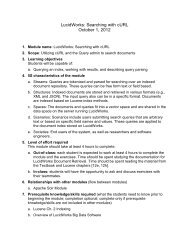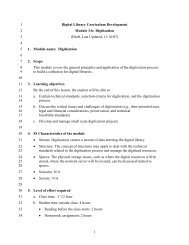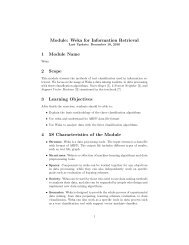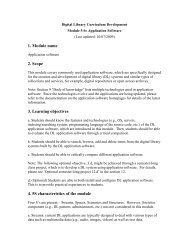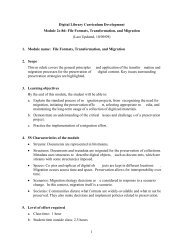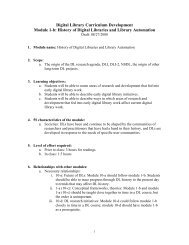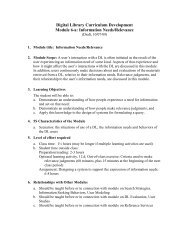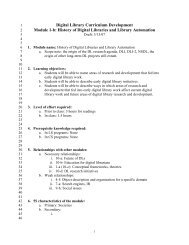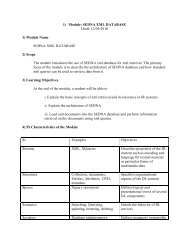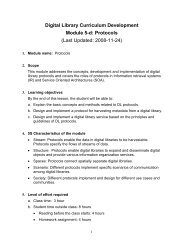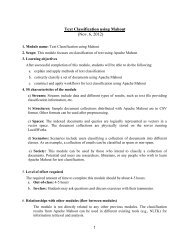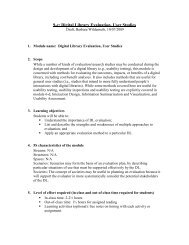Personalization - Digital Library Curriculum Project
Personalization - Digital Library Curriculum Project
Personalization - Digital Library Curriculum Project
Create successful ePaper yourself
Turn your PDF publications into a flip-book with our unique Google optimized e-Paper software.
<strong>Digital</strong> <strong>Library</strong> <strong>Curriculum</strong> Development<br />
7-g: <strong>Personalization</strong><br />
(Draft, 10/09/2009)<br />
1. Module name: <strong>Personalization</strong><br />
2. Scope: This module addresses <strong>Personalization</strong> standards that may be appropriate in<br />
the context of a DL, along with its’ approaches, effects, limitations, and challenges.<br />
3. Learning objectives<br />
Student will be able to:<br />
a. Have a clear understanding of what <strong>Personalization</strong> is and how it can affect <strong>Digital</strong><br />
Libraries<br />
b. Understand various personalization approaches<br />
c. Understand the limitations and challenges of <strong>Personalization</strong><br />
4. 5S characteristics of the module<br />
• Society:<br />
o Where all other personalization dimensions would be organized or<br />
targeted for particular societies of users, e.g., incorporation and adaptation<br />
of specialized services for librarians, professors, and students in a digital<br />
library of theses and dissertations;<br />
• Scenarios:<br />
o Like scenario re-design, by introducing new functions and interaction<br />
techniques, e.g., navigation by context, or by specializing existing ones,<br />
e.g., changes in syntax and parameters for searching;<br />
• Spaces:<br />
o Such as mappings between different spaces (e.g., from vector space<br />
models to probabilistic ones) for interoperability or reduction of
dimensionality for providing better search services (e.g., with Latent<br />
Semantic Indexing (LSI));<br />
• Structures:<br />
o Including restructuring, reduction, or other transformations over<br />
classification systems, ontologies, internal structures of documents, etc;<br />
• Stream:<br />
o Which could include, in the case of textual streams, translations of<br />
language and conversion of encodings, or, in the case of multimedia data,<br />
possible conversions between formats according to a user's platform;<br />
5. Level of effort required (in-class and out-of-class time required for<br />
students)<br />
a. In class: 1.25 hours<br />
b. Outside of class: 2-3 hours for readings<br />
6. Relationships with other modules (flow between modules)<br />
a. Module 6-d (Interaction design, usability assessment)<br />
i. <strong>Personalization</strong> could affect the usability of a digital library<br />
b. Module 9-c (DL evaluation, user studies)<br />
i. <strong>Personalization</strong> can affect a user’s opinion of a DL and have an impact on<br />
the user studies<br />
7. Prerequisite knowledge required (completion optional)<br />
a. Students will not be expected to have had prior training in personalization.<br />
8. Introductory remedial instruction:<br />
a. None<br />
9. Body of knowledge<br />
1. What is <strong>Personalization</strong>?
a. Tailored Services<br />
b. Adapting Presentation<br />
c. Make DL’s accessible<br />
d. Device Examples<br />
i. Eye track<br />
ii. Sense Cam<br />
iii. Preservation migration<br />
2. Goals<br />
3. User Centered<br />
a. Personal Information<br />
i. Profile<br />
ii. Age<br />
iii. Sex<br />
iv. Health<br />
v. Activities<br />
vi. Commerce<br />
vii. Modeling Queries<br />
b. Personal View on Information World<br />
i. Distribution<br />
ii. Services<br />
1. Intelligent Tutoring Systems<br />
iii. Broadcast, on demand<br />
iv. Alerts (Notifications), Interruptions<br />
v. Trails, bread crumbs<br />
c. Capturing Personal Information<br />
i. Eye tracking<br />
ii. Click through logs<br />
iii. Privacy
iv. Analysis<br />
4. Classification of Personalized Methods<br />
a. Content<br />
i. Structuring<br />
ii. Selection<br />
iii. Enrichment<br />
b. Services<br />
i. Special Services<br />
ii. Service Properties<br />
5. Information Filtering<br />
6. Notification<br />
7. Recommender System<br />
a. Definition<br />
i. <strong>Personalization</strong> Service<br />
ii. Most popular DL personalization<br />
iii. Tailors information to individuals<br />
b. Scope<br />
c. Components<br />
i. Background Data<br />
ii. Input Data<br />
iii. Algorithm<br />
d. Types<br />
i. Content-based<br />
1. Contextualization<br />
ii. Knowledge-based<br />
iii. Collaborative Information Filtering<br />
iv. Demographic-based<br />
1. In the community
2. Multiple memberships<br />
3. Roles<br />
v. Utility-based<br />
vi. Hybrid<br />
1. integrated information inference<br />
vii. Community-based<br />
8. Advanced Approaches for <strong>Personalization</strong><br />
a. Personal Reference Libraries<br />
b. Cooperative Content Annotation<br />
c. Personal Web Context<br />
9. Social Effects of <strong>Personalization</strong><br />
a. Individual Experience<br />
b. Community Experience<br />
c. Social Groups<br />
10. Personalized Information Environment (PIE)<br />
a. Collection <strong>Personalization</strong><br />
i. Personalized Filtering<br />
ii. Personalized Retrieving<br />
b. Material <strong>Personalization</strong><br />
11. Evaluation Issues<br />
a. Access <strong>Personalization</strong><br />
b. User-Centered Evaluations<br />
c. Identify Appropriate Criteria<br />
d. Training and Testing<br />
e. Usability<br />
f. Usefulness<br />
g. Performance<br />
h. Failures
i. Types<br />
ii. Causes<br />
iii. Solutions<br />
i. Benefits<br />
i. Memory<br />
ii. Symbiosis<br />
12. Limitations and Challenges<br />
a. Privacy<br />
b. Hinder Findings<br />
c. Hinder Group Communication<br />
d. Predictability<br />
10. Resources<br />
Assigned readings for students:<br />
a. Beaulieu, Micheline, Borlund, Pia, Brusilovsky, Peter, et al (2003).<br />
<strong>Personalization</strong> and Recommender Systems in <strong>Digital</strong> Libraries. Joint<br />
NSF-EU DELOS Working Group Report. Retrieved 11/6/2008 from:<br />
http://www.ercim.org/publication/ws-proceedings/Delos-<br />
NSF/Personalisation.pdf<br />
b. Bollen, Johan, Di Giacomo, Mariella, Mahoney, et al (2001). My<strong>Library</strong>, A<br />
<strong>Personalization</strong> Service for <strong>Digital</strong> <strong>Library</strong> Environments. Joint<br />
DELOS-NSF Workshop on <strong>Personalization</strong> and Recommender<br />
Systems in <strong>Digital</strong> Libraries, Dublin, Ireland, Retrieved 11/9/2008<br />
from: http://www.ercim.org/publication/wsproceedings/DelNoe02/Giacomo.pdf<br />
c. Jewagamage, K. Priyantha, Hirakawa, Masahito, Jayawardana, Champu (2001).<br />
<strong>Personalization</strong> Tools for Active Learning in <strong>Digital</strong> Libraries. MC<br />
Journal: The Journal of Academic Media Librarianship. Retrieved<br />
11/1/2008 from<br />
http://wings.buffalo.edu/publications/mcjrnl/v8n1/active.pdf
d. Neuhold, E.J., Nieder´ee, C., Stewart, A. (2003). <strong>Personalization</strong> in digital<br />
libraries: An extended view. Proceedings of ICADL 2003. (pp. 1–16)<br />
Retrieved 11/1/2008 from<br />
http://www.springerlink.com/content/wc7kybhvtpuaf1y3/fulltext.pdf<br />
e. Dumais, Susan T, Liebling, Daniel J, Teevan, Jaime. To Personalize or Not to<br />
Personalize: Modeling Queries with Variation in User Intent. Retrieved<br />
11/4/2008 from http://portal.acm.org/citation.cfm?id=1390364<br />
f. Aalbert, Trond, Agosti, Maristella, Fuhr, Norbert, et al. (2007) Evaluation of<br />
digital libraries. Retrieved 11/4/2008 from<br />
http://www.springerlink.com/content/w2w0j4h272k26812/fulltext.pdf<br />
Recommended readings for students:<br />
a. M. Elena Renda, and Umberto Straccia (2005). A personalized collaborative<br />
<strong>Digital</strong> <strong>Library</strong> environment: a model and an application. Inf. Process.<br />
Manage., Vol. 41, No. 1., pp. 5-21. Retrieved 11/2/2008 from<br />
http://www.sciencedirect.com/science/article/B6VC8-4CG0NPT-<br />
2/2/91d50b6b47b390024411fc8d594da812<br />
b. Chia, Christopher, Garcia, June (2002). The personalized challenge in public<br />
libraries: perspectives and prospects. Retrieved 11/2/2008 from<br />
http://www.publiclibraries.net/html/x_media/pdf/personalisation_engl.pdf<br />
c. Boardman, R. (2002). Workspaces that work: Towards unified personal<br />
information management. In Proceedings of HCI2002, People and<br />
Computers XVI—Memorable Yet Invisible. Volume 2, 216–7, London.<br />
Retrieved 11/10/2008 from<br />
http://www.iis.ee.ic.ac.uk/~rick/research/pubs/wthatw-hci2002.pdf<br />
d. Jung, Jason J. Personalized Information Delivering Service in Blog-Like <strong>Digital</strong><br />
Libraries. Retrieved 11/10/2008 from<br />
http://www.springerlink.com/content/5312380505287115/fulltext.pdf
Recommended background reading for instructor:<br />
a. Goncalves, M., Zafer, A. A., Ramakrishnan, N., & Fox, E. A. (2001). Modeling<br />
and building personalized digital libraries with PIPE and 5SL. In<br />
Proceedings of the 43rd Joint DELOS-NSF workshop on personalization<br />
and recommender systems in digital libraries, Dublin, Ireland (pp. 67–<br />
72)<br />
b. Neuhold, Erich (2004) Context Driven Access Personalized <strong>Digital</strong> Multimedia<br />
Libraries. Paper presented at the ICDL 2004 Conference hosted by<br />
TERI, New Delhi, India. Retrieved 11/9/2008 from<br />
https://drtc.isibang.ac.in/handle/1849/177<br />
11. Concept Map (created by students)<br />
12. Exercises / Learning activities<br />
e. Pick a <strong>Digital</strong> <strong>Library</strong> and determine five ways in which you<br />
would like to personalize it. Discuss it with the rest of the<br />
class.<br />
f. Look at a <strong>Digital</strong> <strong>Library</strong> and name three ways you think<br />
personalizing it would benefit the users. Discuss it with the<br />
rest of the class.<br />
13. Evaluation of learning objective achievement<br />
a. none<br />
14. Glossary<br />
a. none<br />
15. Additional Useful links<br />
16. Contributors
a. Initial authors: Ashley Robinson, Chester Rosson, Pramodh Pochu,<br />
Sheng Guo<br />
b. Evaluator: Edward A. Fox



